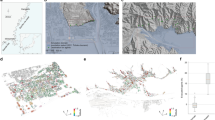Abstract
In this paper, we deal with evacuation decision making of people in the disaster area. By threshold model, we discuss whether all agents decide to evacuate or not. It is reported that not all people in the affected area evacuated during the Great East Japan Earthquake. But, many evacuation simulations treat that all people evacuate. In the previous work, on the assumption that all people decide to evacuate, we dealt with the needed time to make all people evacuate if psychological conditions exist at the time of disaster. In this paper, we deal with the condition that not all people decide to evacuate and focus on contagion of evacuation decision making on real map. We found that for contagion of evacuation decision making, local neighborhood and connection of sub network is necessary.






Similar content being viewed by others
References
Drabek TE, Keith B (1968) Families in disaster: reactions and a relatives. J Marriage Fam 443–451
Epstein JE, Axtell RL (1996) Growing artificial societies: social science from the bottom up (Complex Adaptive Systems). A Bradford Book, Cambridge
Hasan S, Ukkusuri SV (2011) A threshold model of social contagion process for evacuation decision making. Transp Res B Methodol 45(10):1590–1605
Helbing D, Anders J (2010) Pedestrian, crowd and evacuation dynamics. Encycl Complex Syst Sci 16:6476–6495
Hirose H (2004) Why do people fail to escape (in Japanese). Shueisha, Tokyo
Hirose H (2011) Wrest a living from the century of gigantic disaster (in Japanese). Shueisha, Tokyo
Hiroshima Prefecture (2013) Hiroshima prefecture assumption of inundated area by high tide and tsunami (in Japanese). http://www.pref.hiroshima.lg.jp/soshiki/4/tsunamisinsuisouteizu.html
Ishii Y, Kusakari T, Minami S, Takeuchi S, Takahashi A, Tomatsu M (2012) A questionnaire to the people regarding the evacuation from the tsunami caused by the east Japan great earthquake: part 1, For Kushiro city (in Japanese). Proc Architec Inst Jpn, Hokkai-do Chapter Architect Res Meet 85:435–440
Iwanaga S, Matsuura Y (2014) Considering psychological conditions in a tsunami evacuation simulation. In: Laurent A et al (eds.) IPMU 2014, Part I, CCIS 442: 437–446
Iwanaga S, Namatame A (2013) Collective behavior in cascade and Schelling model. 17th Asia Pacific Symposium on Intelligent and Evolutionary Systems IES2013. Proc Comput Sci 24:217–226
Katada T, Kuwasawa N, Yeh H, Pancake C (2006) Integrated simulation of tsunami hazards. EERI’s Eighth U.S. National Conference on Earthquake Engineering 1727
Kure City (2012) Shelters at the time of disaster (in Japanese). http://www.city.kure.lg.jp/kureinfo/info_hinan.pdf
Mas E, Suppasri A, Imamura F, Koshimura S (2012) Agent-based simulation of the 2011 Great East Japan Earthquake/Tsunami Evacuation: an integrated model of tsunami inundation and evacuation. J Nat Disaster Sci 34(1):41–57
NHK Special Collection Team (2013) Mega quake- how human behaved at the time (in Japanese). Iwanami, Tokyo
NHK Special TV Program (2013) To the future the records of lives-big data of earthquake disaster (in Japanese). http://www.nhk.or.jp/
Newman MEJ (2003) The structure and function of complex networks. SIAM Rev 45(2):167–256
Ohata D, Takai N, Kagami H (2007) Spatial evaluation of tsunami refuge facilities in the central Kushiro city: simulation of evacuation behavior from tsunami utilizing multi-agent system Part 2 (in Japanese). Architec Inst Jpn 612:87–91
Perry RW (1979) Incentives for evacuation in natural disaster. J Am Assoc Planners 48(4):440–447
Quarantelli EL (1960) Images of withdrawal behavior in disasters: some basic misconceptions. Soc Probl 8:68–79
Schelling T (1978) Micromotives and macrobehavior. Norton, New York
Social Information Laboratory of Tokyo University, Society for the Study of Disaster and Information (1994) Correspondence of residents and communication of disaster information in Hokkaido Nansei Oki Earthquake of 1993- Huge tsunami and evacuation behavior (in Japanese), Social Information Laboratory of Tokyo University, Tokyo, pp. 11–18
Ushiyama M, Yokomaku S (2012) Great east Japan earthquake and disaster information- special edition- feature of human damage (in Japanese). J Disaster Inf Stud 10:7–13
Watts DJ (2002) A simple model of global cascades on random networks. Proc Natl Acad Sci USA 99(9):5766–5771
Yamakage S (2009) Modeling and expanding artificial societies -the possibilities of an artificial society. Shosekikobo Hayama Publishing, Tokyo
Author information
Authors and Affiliations
Corresponding author
Rights and permissions
About this article
Cite this article
Iwanaga, S., Namatame, A. Contagion of Evacuation Decision Making on Real Map. Mobile Netw Appl 21, 206–214 (2016). https://doi.org/10.1007/s11036-016-0704-x
Published:
Issue Date:
DOI: https://doi.org/10.1007/s11036-016-0704-x




